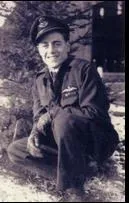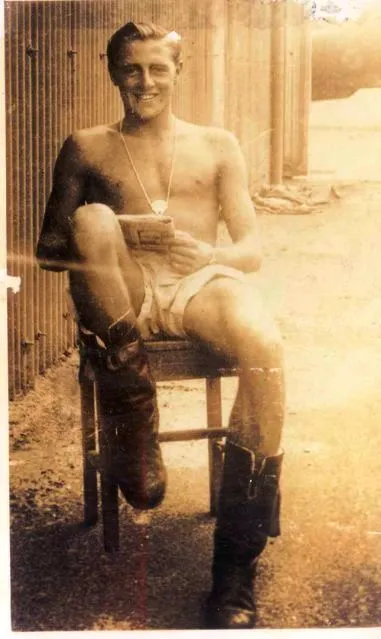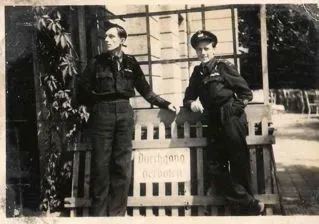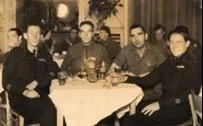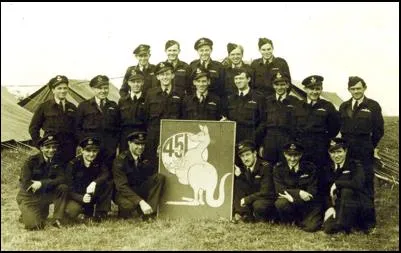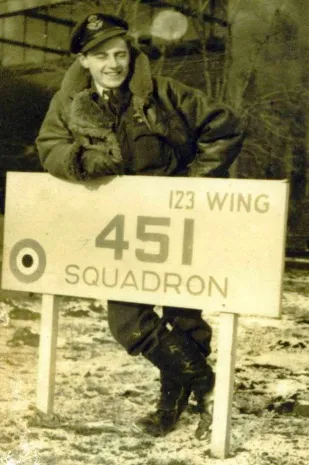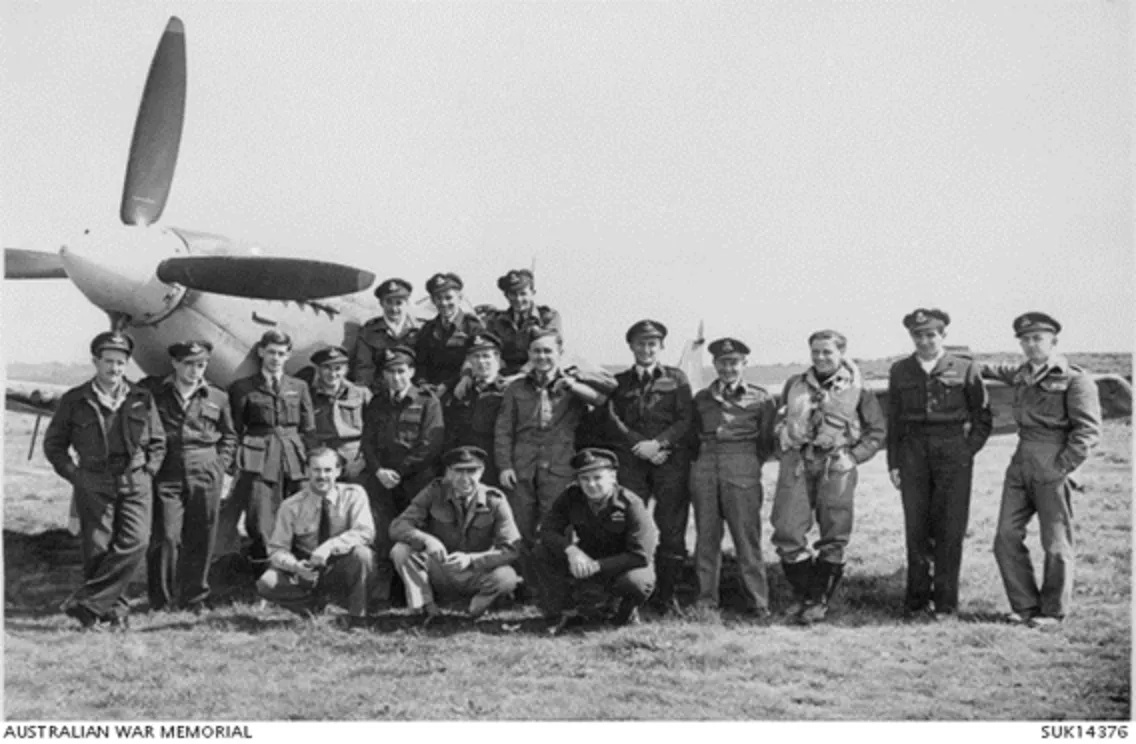FLGOFF Sidney Alwyn Handsaker 421992
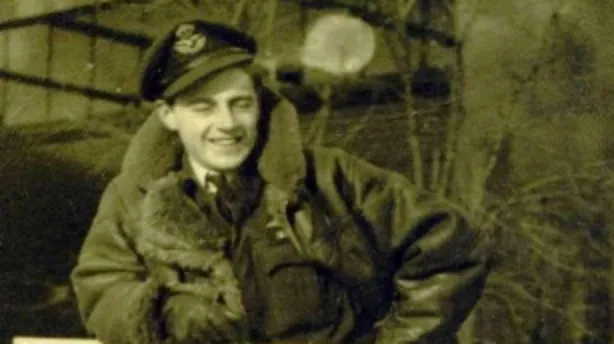


| Squadron/s | 451 SQN |
| Rank On Discharge/Death | Flying Officer (FLGOFF) |
| Nickname | Sid |
| Mustering / Specialisation | Pilot |
| Date of Enlistment | 26 Apr 1942 |
| Contributing Author/s | Sid Handsaker, Ron Elliott, Robert Hamilton The Spitfire Association Reviewed September 2013 |
Sid was accepted in 1941 as Air Crew Reserve and was called up in Newcastle on 26th April 1942 proceeding to Woolloomooloo Sydney and then by train to RAAF Station at Somers in Victoria. He trained there for 3 months learning the basics of Air Force procedures and was selected for Pilot training flying Tiger Moths at Western Junction Tasmania where he was successful and proceeded to Deniliquin NSW to fly Wirraways.
He remembers going solo on his 21st Birthday - where he managed to complete the course, received his Wings and was promoted to Sergeant. He spent the next nine months flying Fairey Battle aircraft at Evans Head NSW, where he accumulated 286 hours and helped to train 450 trainee navigators and air gunners.
With 25 other ex-Evans Head pilots Sid departed March 1944 from Sydney via America to England departing America on the Queen Elizabeth together with 15,000 GI soldiers. Arrival was at Glasgow in April a journey of 5 weeks from leaving Australia. It was raining and this was coupled with fog and smog and they knew that they had arrived in a country that had been battered but not beaten. After being spoilt in America with lots of luxury food and no blackouts they settled down to the duty that they came across to England to carry out.
It was seven months before Sid was to fly again on Tiger Moths, and during this time he was kept busy attending lots of courses, a repeat of all his previous courses in Australia. He was doubly trained and his ambition to be a fighter pilot was realised when he was posted to an Advanced Flying Unit to fly Miles Masters and Harvard aircraft. Many months later he eventually succeeded in flying at an Operational Training unit and graduated to fly Spitfire MK Vs.
The RAF were very skilful in their training methods and Sid enjoyed learning the Skills that were necessary to be a fighter pilot, included night flying. Whilst the Spitfire was a delight to fly during the day, the take-off at night left much to be desired, as the exhausts situated on each side of the cockpit tended to blind you. However the circuit flown was laid out in lights and even Bars of lights were shown to indicate when to lower the undercarriage and flaps. Additionally another aid was the Totem Pole - this was very similar to our road traffic signals which indicated to you in Red - Amber - Green your correct descent path. The layout in coloured lights together with their communication by Radio RT was magnificent - we had nothing like this in Australia.
Sid was to train with eight other nationalities on this course and he was delighted to be posted to 451 RAAF Australian Fighter Squadron to fly MK XV1 Spitfires operating from Matlaske which is on the East coast near the Wash. He was with the Squadron for nine months and enjoyed the life amongst fellow Aussie pilots. His squadron would change bases almost every month and he was to see a lot of the UK from the air.
Life was very exciting and especially when Sid received even faster Spitfires namely MK X1Vs, and he was fortunate to fly three operational flights, one that was particularly exciting on high escort duty to provide top cover for 951 bombers attacking Heligoland Island Submarine Base that was situated approximately fifty miles from the German coast. His squadron together with twelve Mustang and eight other Spitfire squadrons patrolled at 25.000 ft above the target and Sid witnessed the bombs from the Bombers bursting open like flowers opening in slow motion - it was spectacular - until he was to receive a scare when an anti-aircraft shell exploded below his Aircraft and the concussion was so violent causing his engine to quit. He found himself alone and quickly he changed fuel from drop tank to main and rolling on his back aimed at the ocean and he managed to get the propellor rotating so that the engine fired into life allowing him to regain control and re-join the squadron that was now out of sight.
A commission was offered to Sid which he accepted (his rank was Warrant Officer) however an interview for commission was necessary with the AOC in Celle Germany. This entailed a trip in an Anson from England to Germany and his interview being successful and he became a Pilot Officer.
When the War was over and he had survived, Sid was ready for home, having been away from Australia for one and a half years. However his squadron and its sister Squadron 453 were selected to fly to Germany and represent Australia on occupational duties. Sid was there for a further four months and however disappointed he may have felt at the time, he would come to realise how fortunate he was to have had the experience.
451 Squadron departed Lasham England 13 Sept 1945 refuelling at Gilze Rijen Holland and pressed on to Fassberg Germany - Sid said that he thought it was strange not having to keep a lookout for enemy aircraft - but they were there all right lined up on the tarmac awaiting disposal! To view them at close range was at first weird and he did not think he would ever experience such an event. Sid was to have lots of experiences and he recalls, especially with the German people. He found to his astonishment how respectful and courteous to us and how honest they were in any bargaining that was necessary. There was a barter system operating and much could be exchanged for items required by each other, with cigarettes and chocolate being the substitute currency. He was hospitalised for a month with a broken ankle, and eventually was allowed to hobble around on crutches and feeling a need to exercise he paid a visit to the local village. It was not easy as he had to make his way through several feet of snow that lay on the ground. He was laden down with a great coat and was ploughing through the snow when he looked up and approaching him was a German soldier. He noticed his right arm was missing with the empty sleeve pinned to his chest and being totally unprepared for greeting the German saluted Sid with a parade ground salute - with his left arm. Sid was dumfounded and attempting to return his salute on crutches almost took a tumble.
Sid was to celebrate Christmas 1945 in Berlin and there was lots of flying to keep them occupied. He had viewed Berlin from the air and made many trips into the City on recreation. It was strange to see Berlin at night (without street lights) only moonlight beams visible through all the window openings - no glass - the complete chaos and mounds of rubble and desolation - a light showing occasionally in the cellar was the only evidence of people living there.
Eventually Sid's Squadron departed Wunstorf for England 9 Jan 1946, and after refuelling at Coxyde Belgium was finally forced down at Manston England due to very bad weather. Ten days later the Squadron delivered its Spitfires to Brize Norton having been allowed to fly over london and landed 45 minutes later on what was to be Sid's very last trip in a Spitfire.
After many delays the squadron departed Portsmouth on the aircraft carrier HMS Formidable and proceeded via the Suez Canal to Ceylon, arriving in Sydney on the 2nd April 1946.
Sid's family (his Father died suddenly 1943) including his Mother, his fiancé and other members were there to greet him - great jubilation!
He had served four years in the RAAF - two years overseas - circled the globe - flown eight different aircraft - did not prang one - and thanks to the Air Force had enlisted as an immature young man and returned home mature and a much wiser person. Three of his brothers were in the RAAF and all survived, his elder brother Ron served as a wireless operator on Liberator aircraft in 206 SQDN Coastal Command and had almost completed his tour when the War finished. His younger brother Reg served as motor transport driver and also saw overseas service, and his other three brothers all served at various stages in the Army - so his family were well represented during the conflict.
As Sid says,
"I, like everyone else was very pleased when the War was over, I felt that I had ample training and if I had been tested who knows"?
His home balcony is sanctuary to numerous birds on the wing. Butcher birds, magpies, galahs, kookaburras know that this is a drop in centre par excellénce.
An elderly gentleman squats patiently with outstretched hand. Feeding the birds is a daily ritual choreographed to impeccable timing. Along with this comes a gentle voice of invitation calling his friends by name to this outdoor banqueting table.
Sometimes there's a different glint in his eyes as he thinks of "older birds" from far off days when D.H. Tiger Moth biplane trainers would be his kindergarten of the air, later to be followed by Wirraway advanced trainers where this birdman would be introduced into higher degrees of airmanship.
There at Deniliquin's No. 7SFTS in the Riverina he would receive his coveted wings... acknowledgement by the RAAF that this young lad had gained the degree of flying skills to sustain him in his journey towards the stars.
Much later and a world away he would be introduced into the joys of the Supermarine Spitfire as an "apprentice" fighter pilot. There was much to learn and Sid would be up to the task.
The Mark V B & C Spitfire would be his training aircraft, to be replaced later by the Mk XV1 and finally the Mk X1V powered by a Rolls Royce Griffon engine. He was now in the big league and No. 451 RAAF SQN would welcome him warmly.
Across England and onto Germany he would go with his squadron. He was not about to let the side down! But today those distant days are but a memory.
He's retired now after many years with Newcastle Stationers, Davies and Cannington Pty Ltd, as a travelling salesman.
Each afternoon the feeding of his birds repeats a daily ritual and I'm sure his feathered friends have passed the word around that Sid Handsaker is one heck of a gentleman.
I'm sure also that all his flying mates and scout leaders would endorse these sentiments wholeheartedly along with the British Veterans Association and the Spitfire Association.
Keep feeding the birds Sid! You are a credit to all that is good in life.
Ron Elliott
Life Member Spitfire Association
